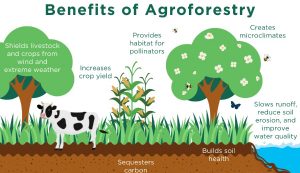Agroforestry
Agroforestry, integrates trees into a cultivation system where trees and hubs share the same surface with crops and/or Livestock. It has plenty of qualities to promote ecological responsibility, enhance production, and promote the versatility of farming areas. Typically, Agroforestry can be defined using the below mentioned four types: Intentional, Intensive, Interactive, Integrated. (Source: https://www.aftaweb.org/about/what-is-agroforestry.html)
Intentional: Rather than as independent aspects, intentionally land’s trees, crops and/or animals are combined and nurtured as a complete cycle.
Intensive: The forestry practices must be intensively carried out which is used to maximize the production comprise periodic activities including irrigation, fertilization, and cultivation.
Interactive: To be able to actively regulate the natural and physical interactions among the tree, crop and animal components.
Integrated: The tree, crop and/or animal components are integrated both structurally and functionally into a single entity.
Difference between Social Forestry and Agroforestry
Social Forestry mainly focuses on social needs of local communities through the preservation and optimal utilization of trees and forests. The objective includes the basic needs such as community development, empowerment, fuelwood, fruits, honey, nuts, mushrooms, gums, food additives, herbs, spices, flavorings, sweeteners, clothing, furniture, construction, perfume fragrance. The scope of Social Forestry is that the Village residents frequently play a role in the management of forests, the distribution of benefits gained from forests through social forestry.
On the other hand, Agroforestry mainly focuses on integrating social forestry with agricultural practices which used to boost agricultural systems’ profitability, environmental responsibility, and ecological benefits. The objective of Agroforestry includes strengthening agricultural adaptation, maximizing food production, safeguarding soil and water resources, and sequestering carbon. The scope is that they can be implemented by Individual harvesters, communities.
Types of Agroforestry
Informal planting Systems
In this type the agricultural crops are intercropped between rows of trees. The trees increase crop yields while providing shade, windbreaks and even bioenergy. Example includes planting Pine, Teak or Rosewood trees in between the annual crops such as Mustard, watermelon, corn, lettuce wheat.
Silvopastoral Systems
In this system, woody plants are strategically planted and spaced out in pastures where livestock feed. It increases animal welfare as well as soil fertility. Example includes combining meadow with scattered tree species such as wattles or acacias where the meadow used in cattle grazing and the trees are used in medicines, baking ingredients, tools, and woodwork.
Agrosilvopastoral Systems
Agrosilvopastoral system refers to the production of perennial woody plants in addition to annuals and pastures which are then grouped into two categories: Home gardens and Woody hedgerows. Examples include maize, vegetables, fruits intercropped with multipurpose trees which can lessen evaporation, safeguard crops from harsh conditions, and enhance microclimates for agricultural growth.
Apiculture with trees
In this system, multiple species of honey producing trees, which honeybees frequently visit, are planted on the outskirts of the agricultural fields. Some tree species produce nectar-rich flowers and vital supply for nectar for honey production. Example of tree species includes American basswood or Linden, black locust and some species of eucalyptus
Aquaforestry
In this system, trees and shrubs are planted around the fish ponds to feed the fish. The trees ate the primary source of supplemental feeds for the fish. Trees can produce insects, fruits, or nuts that may fall into the water, supplying fish with additional nutritional options. In addition with that lowering extensive sun exposure and changes in water temperature.
Why we actually need?
We need to have agroforestry for two main reasons. One is to increase food production and the other is to decrease the pollutions. As the population increased double in the past 50 years, we are in need of producing more food at cheaper prices. Many acres of land, including previously uninhabited forests, have been converted to agriculture in order for that to happen. On the other hand, increased population led to an increased use of chemicals. To overcome these two main concerns, agroforestry is crucial in this era.
Blessings of Agroforestry

Benefits of Agroforestry
Diminish water and air pollution: Agroforestry minimizes air pollution by storing carbon and filtering particulate matter, and it also lessens water pollution by limiting sedimentation and nutrients runoff.
Safeguarding ecological systems: By encouraging biodiversity, growing habitats for species, and maintaining natural resources through environmentally friendly farming techniques.
Capture carbon dioxide: Using trees as carbon sinks, which absorb CO2 from the atmosphere through photosynthesis and store it in their biomass and soils, can help to mitigate climate change.
Enrichment of soil nutrients: Agroforestry systems bolster soil fertility by incorporating nitrogen-fixing trees that contribute to nutrient-rich soil through the deposition of organic matter, including leaf litter and root exudates. This stimulates nutrient cycling, fostering robust growth of crops and vegetation.
Featured Image Source: https://www.bbc.com/future/bespoke/follow-the-food/how-farming-in-forests-could-sustain-the-planet.html

